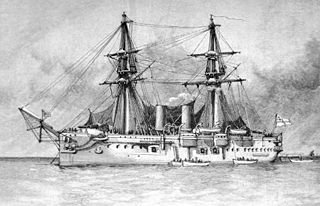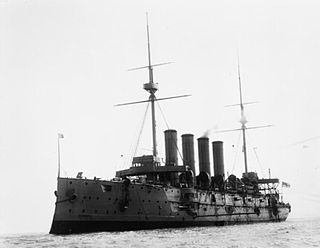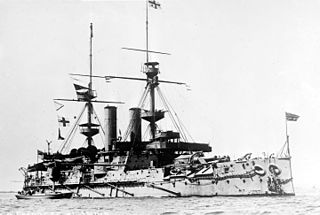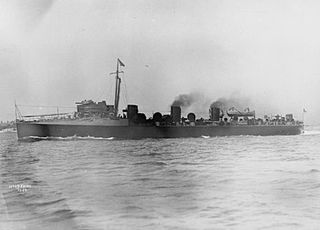
HMS Hawke, launched in 1891, was the seventh British warship to be named Hawke. She was an Edgar-class protected cruiser.

HMS Temeraire was an ironclad battleship of the Victorian Royal Navy which was unique in that she carried her main armament partly in the traditional broadside battery, and partly in barbettes on the upper deck.

HMS Revenge was one of seven Royal Sovereign-class pre-dreadnought battleships built for the Royal Navy during the 1890s. She spent much of her early career as a flagship for the Flying Squadron and in the Mediterranean, Home and Channel Fleets. Revenge was assigned to the International Squadron blockading Crete during the 1897–1898 revolt there against the Ottoman Empire. She was placed in reserve upon her return home in 1900, and was then briefly assigned as a coast guard ship before she joined the Home Fleet in 1902. The ship became a gunnery training ship in 1906 until she was paid off in 1913.

HMS Repulse was one of seven Royal Sovereign-class pre-dreadnought battleships built for the Royal Navy in the 1890s. Assigned to the Channel Fleet, where she often served as a flagship, after commissioning in 1894, the ship participated in a series of annual manoeuvres, and the Queen Victoria's Diamond Jubilee Fleet Review during the rest of the decade. Repulse was transferred to the Mediterranean Fleet in 1902 and remained there until December 1903, when she returned home for an extensive refit. After its completion in 1905, Repulse was assigned to the Reserve Fleet until she was sold for scrap in 1911.

HMS Hannibal was a Majestic-class pre-dreadnought battleship built for the Royal Navy, and the sixth ship to bear the name HMS Hannibal. The ship was laid down at the Pembroke Dock in May 1894, she was launched in April 1896, and commissioned into the fleet in April 1898. She was armed with a main battery of four 12-inch (305 mm) guns and a secondary battery of twelve 6-inch (152 mm) guns. The ship had a top speed of 16 knots.

HMS Diadem was the lead ship of the Diadem-class of protected cruiser in the Royal Navy.

HMS Amphitrite was a ship of the Diadem-class of protected cruisers in the Royal Navy, which served in the First World War.

HMS Andromeda was one of eight Diadem-class protected cruisers built for the Royal Navy in the 1890s. Upon completion in 1899, the ship was assigned to the Mediterranean Fleet where she helped to escort a royal yacht during its cruise through the Mediterranean Sea. After a refit, she was assigned to the China Station in 1904 and returned home three years later to be reduced to reserve. Andromeda was converted into a training ship in 1913 and remained in that role under various names until 1956. That year she was sold for scrap and broken up in Belgium, the last Pembroke-built ship still afloat.

HMS Ariadne was a Diadem-class protected cruiser of the Royal Navy, which was launched in 1898, In March 1913, she was converted to a stokers' training ship and in 1917 was converted to a minelayer and assigned to the Nore Command. She was torpedoed and sunk off Beachy Head by the German submarine UC-65 on 26 July 1917.

HMS Terrible was the second and last of the Powerful-class protected cruisers built for the Royal Navy (RN) in the 1890s. She served on the China Station and provided landing parties and guns which participated in the Siege and Relief of Ladysmith in the Second Boer War in South Africa. A few months later she did much the same thing to help suppress the Boxer Rebellion in China. During this time, her captain was Percy Scott who trained his crew to a high standard in gunnery and had his training methods adopted by the entire Royal Navy.

HMS Aurora was one of seven Orlando-class armoured cruisers built for the Royal Navy in the mid-1880s. The ship spent a brief time in reserve before she was assigned to the Channel Squadron for two years in 1890. In 1893 Aurora became a coast guard ship in Ireland for two years before she was placed in reserve again. The ship recommissioned in 1899 for service on the China Station and some of her crew participated in the Battle of Tientsin in 1900 during the Boxer Rebellion. Aurora returned home two years later and was again reduced to reserve. She was taken out of service in 1905 and sold for scrap on 2 October 1907.

HMS Windsor Castle was a triple-decker, 102-gun first-rate Royal Navy ship of the line. She was renamed HMS Cambridge in 1869, when she replaced a ship of the same name as gunnery ship off Plymouth.

HMS Empress of India was one of seven Royal Sovereign-class pre-dreadnought battleships built for the Royal Navy during the 1890s. The ship was commissioned in 1893 and served as the flagship of the second-in-command of the Channel Fleet for two years. She was transferred to the Mediterranean Fleet in 1897, during which time Empress of India was assigned to the International Squadron blockading Crete during the uprising there. She returned home in 1901 and was briefly assigned as a coast guard ship in Ireland before she became the second flagship of the Home Fleet. The ship was reduced to reserve in 1905 and accidentally collided with the submarine HMS A10 the following year. Empress of India was taken out of service in early 1912 and accidentally struck a German sailing ship while under tow. She was sunk as a target ship in 1913.

HMS Sturgeon was the lead ship of the Sturgeon-class destroyers which served with the Royal Navy. Built by Vickers, she was launched in 1894 and sold in 1910.

HMS Gipsy was a Fairfield-built three-funnel, 30 knot torpedo boat destroyer ordered by the Royal Navy under the 1896 – 1897 Naval Estimates. She was the fourth ship to carry this name. Designated as a C-class destroyer in 1913, Gipsy served on patrol in the First World War operating out of Dover. She was sold for breaking in 1921.

HMS Fisgard was a 46-gun fifth rate Leda-class frigate of the Royal Navy. She spent sixty years in service on a variety of duties.

HMS Cambrian was a second-class protected cruiser, of the Royal Navy, built at the Pembroke Dockyard and launched on 30 January 1893. She was the last flagship of the Australia Station.

HMS Albatross was an experimental torpedo boat destroyer of the Royal Navy authorised under the 1896–97 Naval Estimates and built by John I. Thornycroft & Company of Chiswick on the River Thames. She was contracted to be faster, larger and more powerful than existing designs.

Rear Admiral Burges Watson, was a Royal Navy officer who became Admiral Superintendent, Malta Dockyard.
Admiral Sir Frederic Edward Errington Brock, was a Royal Navy officer.



















